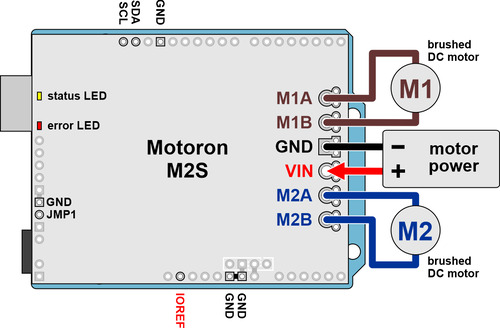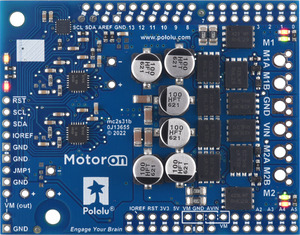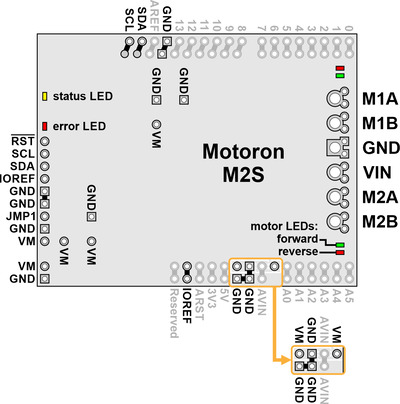
Motoron M2S24v16 Dual High-Power Motor Controller Shield for Arduino (No Connectors)
Tutti i prezzi sono IVA inclusa
The Motoron M2S24v16 Dual High-Power Motor Controller Shield for Arduino makes it easy to control two high-power DC motors from an Arduino or Arduino-compatible board through an I²C interface. The M2S24v16 supports motor supply voltages from 6.5 V to 40 V and can deliver continuous output currents up to 16 A per motor. This version is just the motor controller by itself, without any header pins or terminal blocks included.
Overview
The Motoron M2S family of dual high-power motor controller shields makes it easy to independently control two bidirectional, brushed DC motors with an Arduino or compatible board, such as the A-Star 32U4 Prime. Unlike most of our motor drivers and motor driver shields, the Motoron does not require any PWM outputs or timers on your Arduino. Instead, the Arduino communicates with the Motoron using I²C, so only two I/O lines are needed. Four types are available so you can pick the one with the appropriate operating voltage range and output current capabilities for your project:
 Motoron M2S18v20 Dual High-Power Motor Controller Shield for Arduino |
 Motoron M2S18v18 Dual High-Power Motor Controller Shield for Arduino |
 Motoron M2S24v16 Dual High-Power Motor Controller Shield for Arduino |
 Motoron M2S24v14 Dual High-Power Motor Controller Shield for Arduino |
|
|---|---|---|---|---|
| Absolute max motor supply voltage: |
30 V | 40 V | ||
| Recommended max nominal battery voltage: |
18 V | 28 V | ||
| Max continuous current per channel: |
20 A | 18 A | 16 A | 14 A |
| Available versions: | ||||
Each of the four types above is available in three versions to provide different options for the through-hole connectors: they can be purchased as an assembled product with stackable headers and terminal blocks soldered in, as a kit with connectors included but not soldered in, or as a standalone board without connectors.
 |
For a lower-power, lower-cost alternative Arduino shield, please consider the Motoron M3S256 Triple Motor Controller Shield for Arduino.
Details for item #5047
 |
Motoron M2S24v16 Dual High-Power Motor Controller Shield for Arduino, top view. |
|---|
The M2S24v16 shield supports motor supply voltages from 6.5 V to 40 V (absolute maximum, not intended for use with 36 V batteries) and can deliver continuous output currents up to 16 A per motor. The M2S24v16 can be distinguished from other types of M2S shields by its larger discrete MOSFETs and the number 100 on top of the tall silver electrolytic capacitors.
This version is just the assembled PCB module as shown above, with no connectors included. It is also available with connectors soldered or as a kit with connectors included but not soldered in.
 |
Motoron M2S Dual High-Power Motor Controller Shield pinout. |
|---|
Features and specifications
- Two motor control channels allow for independent control of up to two bidirectional brushed DC motors
- Reverse-voltage protection on motor power supply
- Logic voltage range: 3.0 V to 5.5 V
- Control interface: I²C
- I²C clock speed: up to 400 kHz
- Optional cyclic redundancy checking (CRC)
- Configurable motion parameters:
- Max acceleration/deceleration forward/reverse
- Starting speed forward/reverse
- Direction change delay forward/reverse
- PWM frequency: eight options available from 1 kHz to 80 kHz
- Current sensing
- Configurable hardware current limiting
- Command timeout feature stops motors if the Arduino stops functioning
- Configurable automatic error response
- Motor power supply (VIN) voltage measurement
- Optional pins make it easy to power the Arduino from reverse-protected motor power, either directly or through an external regulator (not included)
- Two status LEDs
- Motor direction indicator LEDs
- Motoron Arduino library simplifies getting started using the Motoron with an Arduino or compatible controller
- Comprehensive user’s guide
Real-world power dissipation consideration
The MOSFETs can handle large current spikes for short durations (e.g. 100 A for a few milliseconds), and the driver’s current chopping will keep the average current under the set limit. The peak ratings are for quick transients (e.g. when a motor is first turned on), and the continuous rating is dependent on various conditions, such as the ambient temperature. PWMing the motor will introduce additional heating proportional to the frequency. The actual current you can deliver will depend on how well you can keep the motor driver cool. The driver’s printed circuit board is designed to draw heat out of the MOSFETs, but performance can be improved by adding a heat sink or air flow. For high-current installations, the motor and power supply wires should also be soldered directly instead of going through the 5mm blue terminal blocks, which are rated for up to 16 A.
Warning: This motor driver has no over-temperature shut-off. An over-temperature or over-current condition can cause permanent damage to the motor driver. You might consider using either the shield’s current sense or an external current sensor to monitor your current draw.
This product can get hot enough to burn under normal operating conditions. Take care when handling this product and other components connected to it.
The Motoron family
The tables below list the members of the Motoron family and show the key differences among them. Each type is available in several versions to provide different options for the through-hole connectors: they can be purchased as an assembled product with connectors soldered in, as a kit with connectors included but not soldered in, or (for Arduino and Raspberry Pi expansions) as a standalone board without connectors.
|
Motoron motor controllers micro versions |
||||
 M1T550  M1U550 |
 M2T550  M2U550 |
 M1T256  M1U256 |
 M2T256  M2U256 |
|
|---|---|---|---|---|
| Control interface: | I²C or UART serial | |||
| Motor channels: | 1 (single) | 2 (dual) | 1 (single) | 2 (dual) |
| Minimum motor supply voltage: |
1.8 V | 4.5 V | ||
| Absolute max motor supply voltage: |
22 V | 48 V | ||
| Recommended max nominal battery voltage: |
16 V | 36 V | ||
| Max continuous current per channel: |
1.8 A | 1.6 A | 2.2 A | 1.8 A |
| Logic voltage range: | 3.0 V to 4.9 V(1) | 3.0 V to 5.5 V | ||
| Available versions with I²C: |
||||
| Available verions with UART serial: |
||||
| Price: | $12.49 – $14.49 | $15.95 – $17.95 | $16.95 – $18.95 | $23.95 – $25.95 |
| 1 The M1x550 and M2x550 are not recommended for use with 5V nominal logic. | ||||
|
Motoron motor controllers Arduino and Raspberry Pi form factor versions |
||||||
 M3S550  M3H550 |
 M3S256  M3H256 |
 M2S24v14  M2H24v14 |
 M2S24v16  M2H24v16 |
 M2S18v18  M2H18v18 |
 M2S18v20  M2H18v20 |
|
|---|---|---|---|---|---|---|
| Control interface: | I²C | |||||
| Motor channels: | 3 (triple) | 2 (dual) | ||||
| Minimum motor supply voltage: |
1.8 V | 4.5 V | 6.5 V | |||
| Absolute max motor supply voltage: |
22 V | 48 V | 40 V | 30 V | ||
| Recommended max nominal battery voltage: |
16 V | 36 V | 28 V | 18 V | ||
| Max continuous current per channel: |
1.7 A | 2 A | 14 A | 16 A | 18 A | 20 A |
| Logic voltage range: |
M3S550 3.1 V to 5.5 V |
3.0 V to 5.5 V | 3.0 V to 5.5 V | |||
|
M3H550 3.0 V to 4.9 V(1) |
||||||
| Available versions for Arduino: |
M3S550 | M3S256 | M2S24v14 | M2S24v16 | M2S18v18 | M2S18v20 |
| Available versions for Raspberry Pi: |
M3H550 | M3H256 | M2H24v14 | M2H24v16 | M2H18v18 | M2H18v20 |
| Price: | $20.95 – $30.95 | $34.95 – $44.95 | $59.95 – $69.95 | $115.95 – $124.95 | $59.95 – $69.95 | $95.95 – $104.95 |
| 1 The M3H550 is not recommended for use with 5V nominal logic. | ||||||








